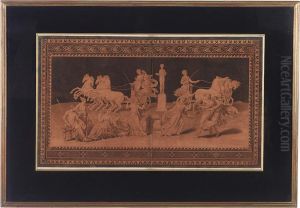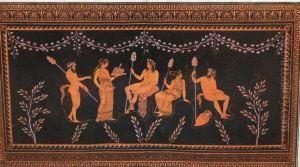Pierre F. Hughes D' Hancarville Paintings
Pierre-François Hugues, known as 'D'Hancarville', was an art historian and historian of ideas, born in 1719 in Nancy, France. His background was somewhat mysterious, and he often presented himself under the guise of the more aristocratic 'D'Hancarville'. He is best known for his work with Sir William Hamilton, the British ambassador to Naples, as the author of the collection of engravings known as 'Collection of Etruscan, Greek, and Roman antiquities from the cabinet of the Honble. Wm. Hamilton', which was published in four volumes from 1766 to 1776.
D'Hancarville's role was to catalog, describe, and interpret the vast collection of ancient vases, statues, and other artifacts that Hamilton had amassed during his time in Italy. His interpretations of the images on the vases were innovative at the time, as he attempted to reconstruct the myths, religious beliefs, and customs of the ancient civilizations that produced them. The volumes of engravings were not only significant in the study of antiquities but also greatly influenced contemporary neoclassical art and design.
While D'Hancarville's scholarship was groundbreaking, it was not without controversy. His methods were often speculative, and his fanciful reconstructions and interpretations of the ancient world were sometimes based more on his imagination than on scientific evidence. Nonetheless, his work was influential in the development of the field of art history and the study of classical antiquities.
D'Hancarville led an adventurous and somewhat troubled life, marked by financial difficulties and frequent moves around Europe to escape his creditors. Despite these personal challenges, his work left an indelible mark on the disciplines of art history and archaeology. He died in poverty in Padua, Italy, in 1805, but his contributions to the study of ancient art continue to be recognized by scholars and enthusiasts of classical culture.
![[greek And Roman Terra Cotta Vases]: Six Plates](https://www.niceartgallery.com/imgs/506378/s/pierre-f-hughes-d-hancarville-greek-and-roman-terra-cotta-vases-six-plates-b1ac774a.jpg)

